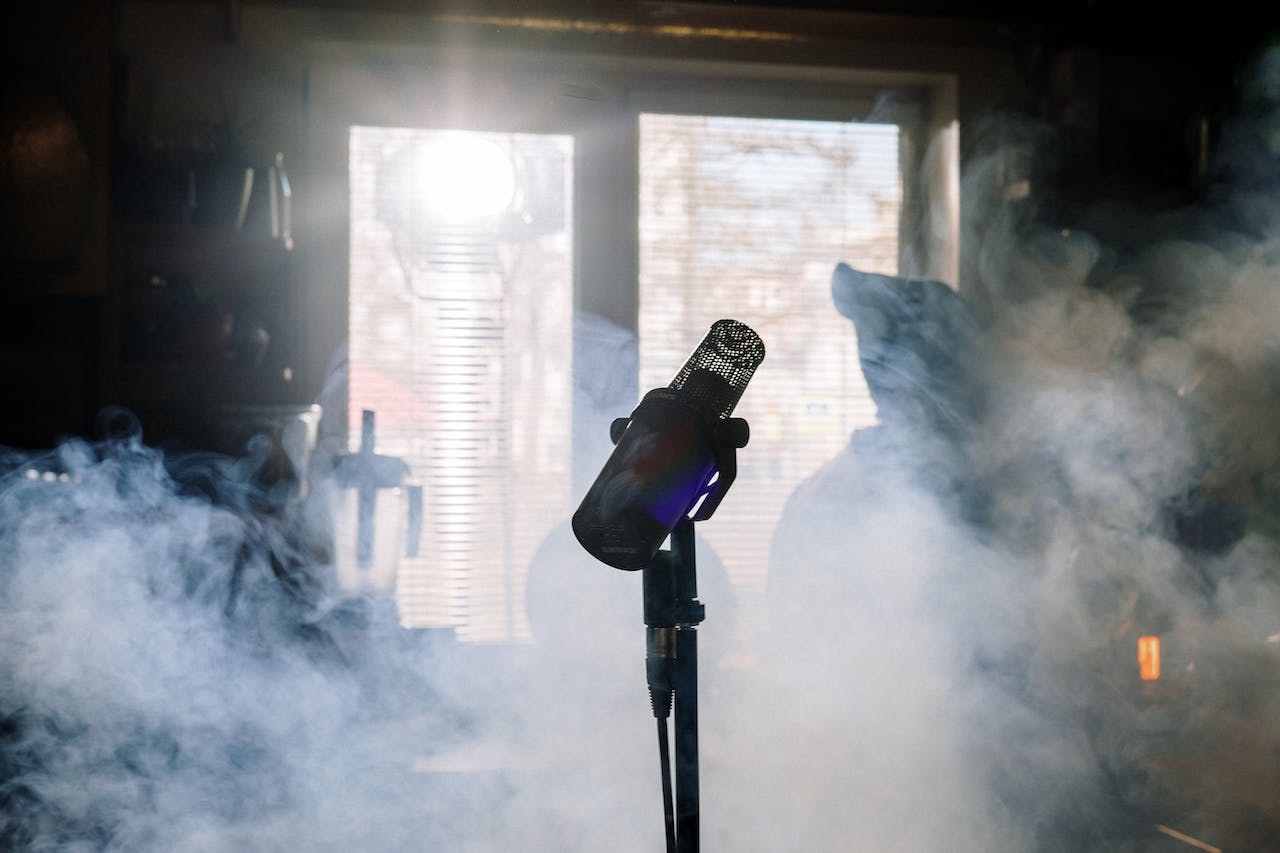In the vast realm of audio equipment for podcasts, the stage floor mic stands out as a unique and indispensable tool. Whether you’ve attended a theatrical performance where they amplify actors, participated in a corporate conference, or simply enjoyed a live musical concert with percussive dance, chances are you’ve experienced the magic of floor mics without even realizing it. These microphones, discreetly placed on the ground, capture sound in a way that other mics can’t, especially on stage floors.
In this article, we’ll journey through the world of floor mic, exploring their history, types, key features, and much more. By the end, you’ll have a comprehensive understanding of these remarkable devices and might even add to cart if you consider incorporating one into your sound setup.
Related: The Best Microphones For Recording in Podcasting
Contents
What Is A Floor Microphone?
A floor microphone, as the name suggests, is a microphone specifically designed to be placed on the floor. Unlike traditional handheld or stand-mounted microphones, floor mics are optimized to capture sound waves that travel parallel to the ground.
This unique positioning allows them to pick up sounds that other microphones might miss, such as footsteps or the subtle nuances of musical instruments.
Common Uses And Applications

Image by pikisuperstar on Freepik
Floor microphones are versatile and find applications in a variety of settings:
- Theatrical Performances: Actors moving across the stage, the rustle of costumes, or even the sound of props can be captured in detail with a bartlett stage floor microphone.
- Conferences and Corporate Events: They ensure that speakers are heard clearly, even if they move away from the podium.
- Live Music Performances: This is especially useful for picking up instruments like kick drums or cajons that produce sound waves close to the ground. Here, a boundary mic can be of great use.
- Broadcasting: Often used in television studios to capture dialogues or sounds without the mic being visible in the frame.
History And Evolution Of Floor Mics
The journey of floor microphones is a fascinating tale of innovation and adaptation. From their rudimentary beginnings to the sophisticated devices we see today, floor mics have undergone significant transformation. One of the advancements is the stage floor mic ec technology.
Early Beginnings
The inception of floor microphones can be traced back to the early 20th century when sound engineers sought ways to capture audio without obstructing the view, especially in theatrical settings. These early mics were bulky, often hidden beneath props or set pieces.
However, their ability to capture ambient sounds and the nuances of performances made them an instant hit. The inclusion of phantom power was a significant leap during these early phases. Over the years, as technology advanced, these mics became smaller, more discreet, and more efficient.
Modern-Day Advancements
Today’s floor microphones are a testament to technological prowess. With the advent of digital technology and the need for gain before feedback, they have become more sensitive and capable of capturing a wider range of frequencies. Modern floor mics are also designed to minimize unwanted noise, such as echoes or feedback. Wireless microphones have also been a revolutionary addition to this realm, allowing for greater flexibility and fewer restrictions on movement.
Features like wireless connectivity, water resistance, and extended battery life have made them more versatile and user-friendly. From being mere sound-capturing devices, they’ve evolved into tools that enhance the overall auditory experience.
Types Of Floor Microphones

Image by wavebreakmedia_micro on Freepik
The world of floor microphones is diverse, with each type designed to cater to specific needs and environments.
Boundary Microphones
Boundary microphones, also known as “plate microphones,” are designed to capture sound waves reflected off surfaces. They are typically flat and are placed directly on a surface, allowing them to pick up sounds with clarity and precision.
These mics are ideal for theater productions, conference rooms, and other settings where ambient sound capture is essential.
Pressure Zone Microphones (PZM)
PZM microphones operate on the principle of capturing sound waves in the “pressure zone,” an area where direct and reflected sound waves converge. This design ensures a clear and natural sound capture, making PZMs popular in broadcasting and studio recording.
Contact Microphones
Contact microphones are unique as they capture sound through contact with objects. They are often attached to surfaces and pick up vibrations, converting them into audible sounds. These mics are especially useful in experimental music, sound design, and certain scientific applications.
Key Features To Consider When Choosing A Floor Mic
Selecting the right floor microphone is crucial to ensure optimal sound capture. While the specific requirements might vary based on the intended use, there are certain universal features that one should consider.
Sensitivity And Sound Quality
The primary function of any microphone is to capture sound, and the quality of this capture is paramount.
- Understanding Sensitivity Ratings: Sensitivity refers to how well a microphone converts acoustic pressure into an electrical signal. A higher sensitivity rating indicates that the mic can pick up quieter sounds effectively. It’s essential to choose a mic with a sensitivity rating suitable for your environment.
- Importance of Frequency Response: Frequency response denotes the range of frequencies a microphone can capture. A broader frequency response ensures that the mic can pick up both low and high-pitched sounds with clarity. For music recordings or performances, a wide frequency response is crucial.
Durability And Build
A robust build ensures that the microphone can withstand regular use, especially in environments like stages where they might be subjected to foot traffic.
- Material: Opt for mics made of durable materials like metal or high-quality plastic.
- Water and Dust Resistance: Some mics come with protective features to prevent damage from moisture or dust, especially useful for outdoor events.
Connectivity Options
The way your microphone connects to recording or sound systems is vital.
- Wired vs. Wireless: While wired mics offer a stable connection, wireless options provide flexibility and reduce clutter.
- Connection Type: Ensure the mic’s connection type (XLR, USB, etc.) is compatible with your equipment.
Power Source And Battery Life
Especially for wireless mics, consider how they are powered. A long battery life ensures uninterrupted use, while some mics offer the convenience of rechargeable batteries.
Directionality and Polar Patterns
Understanding the direction from which the mic picks up sound can help in optimal placement.
- Omnidirectional: Captures sound from all directions, ideal for ambient sound.
- Cardioid: Picks up sound primarily from the front, reducing background noise.
Setting Up And Using Floor Microphones
Using a floor microphone effectively requires more than just placing it on the ground. Proper setup can significantly enhance sound quality.
Proper Placement Techniques
The art of placing a floor microphone is more nuanced than one might think. It’s not just about setting it down; it’s about understanding the environment, the sound sources, and the microphone’s capabilities. Proper placement ensures that the microphone captures the desired sound with clarity while minimizing unwanted noise or feedback.
- Location: Place the mic where it can best capture the desired sound without obstructions.
- Angle: Some mics capture sound best when angled correctly, especially if they have specific directional patterns.
- Avoid Feedback: Ensure the mic is placed away from speakers to prevent feedback loops.
Maintenance And Care
To ensure longevity and consistent performance, regular maintenance of your floor microphone is essential.
Cleaning and Storage
Regular cleaning and proper storage of your floor microphone are essential to maintain its performance and extend its lifespan. Over time, microphones can accumulate dust, debris, and even moisture, which can affect their functionality.
It’s advisable to clean the microphone gently with a soft cloth after each use, ensuring that no moisture seeps into its internal components. When storing the microphone, it’s best to place it in a protective case. This not only shields it from potential damage but also keeps it free from dust and other contaminants.
Periodic Checks and Repairs
Like any piece of equipment, floor microphones are subject to wear and tear. It’s crucial to periodically inspect your microphone for any signs of damage or malfunction. This includes checking the cable, connectors, and the microphone’s body for any visible signs of wear.
If you notice any irregularities in sound quality or functionality, it might be time to seek professional repairs. Remember, timely intervention can prevent minor issues from escalating into major problems.
Conclusion: Is A Floor Mic Right For You?
In wrapping up our exploration of floor microphones, it’s clear that these unique devices have carved out an indispensable niche within the audio equipment landscape. Their design, tailored specifically to capture sound waves that travel close to the ground, has made them a go-to tool for varied applications, from theatrical performances to live music and broadcasting. Modern technological advancements, paired with the rich history of these mics, highlight their continuous evolution to meet the dynamic demands of sound capture.
As audio enthusiasts, theater directors, or sound engineers, recognizing the capabilities of floor microphones is paramount. They not only ensure clarity of sound but also add depth and richness to the auditory experience. If you’re looking to elevate the quality of sound capture in any setting, delving into the world of floor mics might just be the answer.
With the knowledge you’ve gained from this article, you’re well-equipped to make an informed decision about integrating a floor microphone into your sound toolkit.

